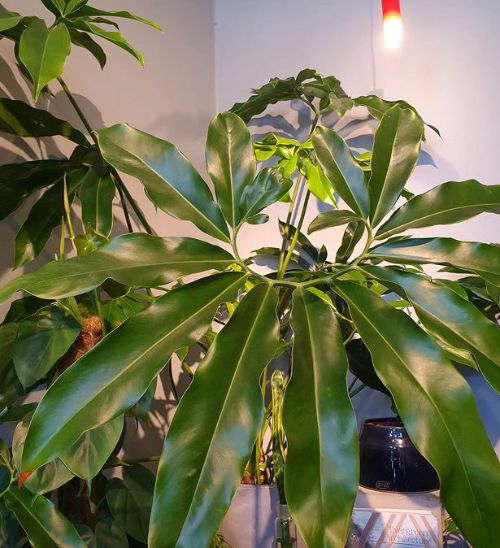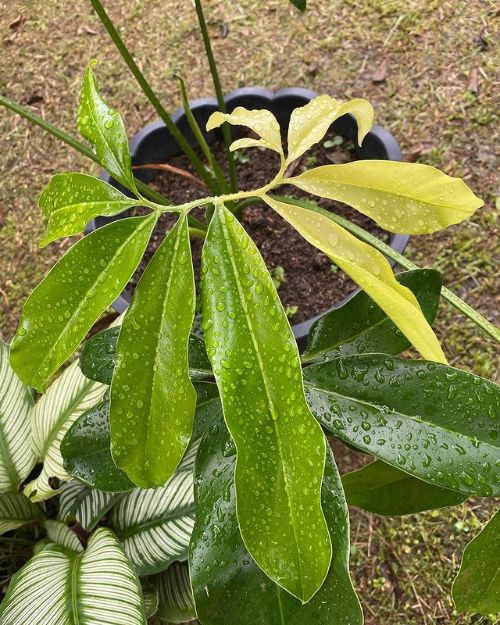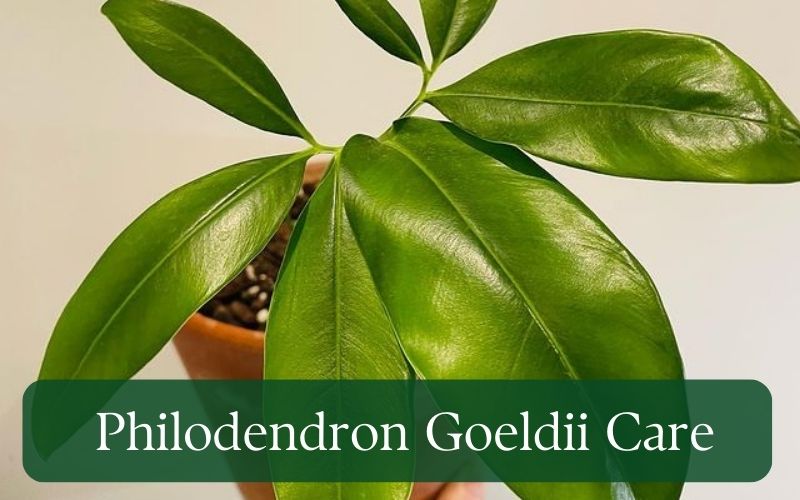Famous for its eye-catching leaves, this Philodendron Goeldii’s a breeze to care for. Sure, it’s a tad hard to find and also called ‘Tree Philodendron’, but trust me, the leaf shape alone’s worth the fuss. Check out our care guide to avoid those green leaves going dull. And remember, easy care ain’t the same as no care. So stick Philodendron Goeldii care and discover how to keep your leafy thriving!
About Philodendron Goeldii care
Hailing all the way from French Guiana, the Philodendron Goeldii, also fondly known as the Finger Leaf. With its long, clustered leaves resembling fingers (hence the nickname), this beauty is a head-turner!
With its infinite growth potential, Philodendron Goeldii can adapt to life indoors and outdoors. As this philodendron ages, it develops vines that hitch a ride on other plants.
Philodendron Goeldii has a fast growth rate, especially in spring and summer. According to Evergreen Seeds, Philodendron Goeldii can shoot up to eight inches tall and four inches wide. So, a pot with a diameter of at least 10 inches will be perfect for a full-grown plant.
Remember, the Philodendron Goeldii is not just about good looks. It will turn into a healthy, bright green buddy with a few simple care steps. Ready to uncover the mysteries of Philodendron Goeldii care? Let’s dive in!

Philodendron Goeldii care overview
| Botanical Name | Philodendron Goeldii, Thaumatophyllum spruceanum |
| Common Name | Finger Leaf, Fun Bun |
| Family | Araceae |
| Origin | French Guiana |
| Growth Rate | Medium |
| Type | Climbing vine |
| Identification | Green foliage with leaves that form in a ring |
| Soil | Well-draining soil |
| Temperature | 50-85 °F |
| Light | Bright indirect sunlight |
| Watering | Allow the top two inches to dry out before watering |
| Humidity | Average (40% – 60%) |
| Fertilizer | Once a month during the growing season |
| Propagation | Stem cuttings |
| Toxicity | Toxic to humans and pets |
Philodendron Goeldii care
Its unique spiral-shaped leaves and the fact it’s pretty easy to look after makes this philodendron species a standout among others. This guide is here to give you all you need to know on Philodendron Goeldii care, from what type of soil it likes to its ideal light conditions, temperature, watering, humidity, and loads more. So let’s jump in and find out how to care for this green stunner in your home.
Soil
Philodendron Goeldii, like most philodendrons, does best in rich, well-draining soil that stays moist but never waterlogged. To get the best-growing conditions for your plant, you might want to think about a mix of regular potting soil, sphagnum moss, and peat-based compost. These plants thrive in a soil pH range of 5 to 8, meaning they like slightly acidic to mildly alkaline conditions.
To make sure your Philodendron Goeldii grows as best as it can, a soil mix chock-full of organic matter is key. Adding sphagnum peat moss to your soil is a smart move. This stuff made up of decomposing plant stuff and even dead insects, is full of nutrients and holds onto moisture effectively. Plus, sphagnum peat moss helps keep a steady soil pH, making a stable environment for your plant’s roots.
If you’re a newbie to gardening, going with clay or terracotta pots can be a good move for your Philodendron goeldii. These materials soak up extra moisture better than plastic or ceramic pots, cutting down the risk of overwatering and root rot.
But, if you’re a bit hit-or-miss with watering, classic plastic pots might work better for you. These pots hold water for longer periods, stopping your Philodendron Goeldii from drying out if you forget a water or two.
Light Requirements
Your Philodendron Goeldii loves the shine of indirect sunlight, enjoying places with medium to low light. When you’re settling it into its new home, make sure to keep it out of direct sunlight so it doesn’t dry out and damage its delicate leaves.
The best place for your Philodendron Goeldii is near a north-facing window or door, giving a steady stream of soft light without direct sun exposure. During the winter, if your plant’s usually outside, bring it in to keep it safe from the cold, but make sure it still gets plenty of sunlight.

Temperature
Philodendron Goeldii, being a tropical plant, loves warmer climates and grows the best in temperatures between 50-85 °F. While it can handle a bit of chill, it’s important not to let this plant get too cold.
Cold weather can make your Philodendron Goeldii wilt and lose leaves. If you live somewhere where it gets really cold, or if frost is a regular thing, it’s a good idea to bring your plant indoors. Giving your plant a warm, well-lit spot during colder months will help it stay safe and healthy.
Watering
Philodendron Goeldii thrives best with a well-planned watering routine, adapting to its specific requirements during the active and dormant growth stages.
During the growing time in spring and summer, Philodendron Goeldii wants regular water. Aim to water your plant twice weekly, make sure there’s a bit of a gap between the two watering sessions. It’s important to remember that during these warmer months, the Philodendron Goeldii likes its soil to stay wet.
When watering, this amount of water is super important for the plant’s healthy growing time. However, don’t overwater it. The water should drain out within seconds of watering, ensuring the plant never stands in excess water. Too much water can cause root rot, a condition that can severely harm or even kill your plant.
The watering routine of Philodendron Goeldii changes a lot during the winter months. As the plant goes into sleep mode and slows its growth, it wants less water, and it can be watered every 10-14 days. Overwatering during this period can be harmful, leading to the chance of getting root rot due to the decreased absorption rate of the soil.
To check if your Philodendron Goeldii plant needs to be watered, stick your finger into the soil. If the top 2 inches of soil are dry, it’s time to water the plant. Water the plant until the water runs out of the holes at the bottom of the pot.

Humidity
The Philodendron Goeldii, a tropical indoor plant, does great under specific conditions of high humidity. Humidity levels between 40-60% are perfect for the lush and vibrant growth of its leaves. Keeping a moist environment for your Philodendron Goeldii leads to bigger, greener leaves and overall healthier plant development.
If the humidity levels around your Philodendron Goeldii plant are too low, it may start to show signs it’s stressed, like wilting leaves. In regions experiencing dry, hot weather, boosting the humidity around might need some work. Simple strategies such as using humidifiers or adding humidity trays can really up the moisture around the plant.
A homemade humidity tray can be easily put together by filling a shallow tray with water and pebbles. By positioning your potted Philodendron Goeldii above this tray, you can naturally up the humidity levels as the water slowly evaporates.
While high humidity is super important for the health of Philodendron Goeldii, it’s crucial to balance it with proper air circulation. A stagnant environment with high humidity can expose the plant to problems such as root rot and other fungal diseases. Hence, making sure there’s enough air moving around the plant is a crucial aspect of plant care.
Fertilizer
The Philodendron Goeldii likes balanced, slow-release fertilizers. A 10-10-10 ratio fertilizer, denoting equivalent proportions of nitrogen, phosphorus, and potassium, is recommended for use once a month during the plant’s growth period. Use this fertilizer at half-strength to nurture the plant without the risk of leaf burn.
Over-fertilization causes the edges of the leaves to transition from yellow to brown and crisp, significantly marring the plant’s lush green aesthetic.
Should over-fertilization occur, it’s crucial to get rid of the extra nutrients quickly to prevent further harm to the plant. This can be done by rinsing the soil with water using a spray hose attachment. The water washes out the extra nutrients as it drains from the pot.
A sign that you’ve given too much fertilizer is a white, salty crust on the soil’s surface. This means there’s a build-up of nutrients that can clog the soil, keeping the roots from getting oxygen, and leading to root rot. If you’re uncertain about the last time the plant was fertilized, err on the side of caution and wait a bit before the next feed.
Regular fertilization during the spring and summer months will yield the best results. However, it’s important to avoid fertilizing during winter as the plant enters a dormant stage with negligible new growth.
Related: Philodendron Camposportoanum Care And Grow: The Ultimate Guide
Repotting
Philodendron Goeldii should be repotted every 2 to 3 years. These plants don’t like being repotted often.
If your Philodendron goeldii catches a fungus, you gotta repot right away. Before repotting, gently take out any sick parts and use some fungicide to stop more fungus from showing up. This will help protect the health of the plant.
When repotting Philodendron goeldii, choose a clay pot that is approximately 2-3 inches larger than the current pot or about 2 inches bigger than the size of the root ball. You gotta give enough room for the plant’s roots to spread out. However, since Philodendron goeldii likes it a bit cramped, it is best to repot when the roots start sticking out of the pot.
Pruning
Pruning Philodendron goeldii is generally not required, as they naturally have a compact growth habit. However, in certain situations, pruning can be beneficial for maintaining the plant’s health and appearance. Here are some updated guidelines for pruning Philodendron goeldii based on current knowledge:
- Removal of Decay and Yellowing Leaves:
If you notice any decayed or yellowing leaves on your Philodendron goeldii, it is recommended to prune them off. Removing these leaves helps maintain the overall health and aesthetics of the plant. - Pruning in Response to Pests:
Philodendron goeldii can be susceptible to pests like mealybugs, aphids, spider mites, and scales. If you observe an infestation, it is crucial to take prompt action. Apply neem oil to control and treat the pest problem, and consider pruning off any damaged parts that are heavily affected by the pests. - Pruning Unhealthy Leaves:
It is important to monitor the health of the leaves on your Philodendron goeldii. If you notice any signs of disease, damage, or yellowing, prune those leaves to maintain the plant’s overall well-being. Pruning unhealthy leaves can help prevent the spread of any potential issues and promote healthier foliage.
Remember, pruning can be performed at any time of the year for Philodendron goeldii. However, if you specifically aim to encourage optimal growth, early spring is considered an ideal time for pruning.

Philodendron Goeldii Propagation
Philodendron goeldii can be propagated through stem cuttings and air layering methods, with stem cuttings being the preferred choice due to higher success rates. Here are updated guidelines for propagating Philodendron goeldii:
Stem Cuttings
- Pick a good stem that’s 2 to 3 inches long with at least one node, the place where new growth happens.
- Keep only the top two to three leaves and get rid of the rest.
- Prepare a well-draining soil mixture and plant the cutting, ensuring that the leaves do not touch the soil.
- Place the cutting in a partially shaded spot near a window and water it regularly to facilitate root growth.
- After a few weeks, the cutting will develop roots and can be transplanted into a larger pot.
Air Layering Method
Another way is air layering, using an existing Philodendron Goeldii plant.
- Find a good stem with at least two nodes.
- Get rid of extra leaves from the stem and make a vertical cut in the bark.
- Ready a bag with moist sphagnum moss and cut a vertical strip on the edge to wrap around the stem.
- Tie the bag tight with the moist sphagnum moss around the stem, but not too tight.
- Leave the bag on for about four weeks, keeping the moss moist.
- When roots start showing and breaking out of the bag, cut below the rooted part of the stem.
- Then, move the rooted stem into a pot with well-draining soil.
Don’t forget to take care of the Philodendron Goeldii. It needs the right light, temperature, and water to grow well.

Philodendron Goeldii Care Common Pests, Plant Diseases
Philodendron Goeldii is a breeze to look after, but it can sometimes run into some problems like too much water, bugs, and sicknesses. However, if you know what you’re doing and act fast, you can keep your plant happy and strong. In this section, we will talk about some common bugs and sick plant signs and how to handle them the right way.
Scale Insects
Scale insects are these small, hard-bodied that can appear in different colors, including brown, yellow, reddish, or white. Although they may not move visibly, they can go after the plant in groups and feed on all parts of the Philodendron Goeldii. Look for these bugs or watch out for yellow or brown spots on the plant’s leaves. To get rid of scale bugs, wet a Q-tip with rubbing alcohol or insecticidal soap and carefully wipe them off the plant. Once the plant is free from scale insects, use a neem oil spray to keep up protection against future infestations.
Spider Mites
Spider mites are teeny-weeny bugs that can be challenging to detect initially. You might see yellow spots on the leaves and holes where the spider mites have fed on the sap. Spider mites love dry places, indicating low humidity levels. To wipe out spider mites and help your Philodendron Goeldii recover, use neem oil or a horticultural spray once a week. Regular application of these treatments will make your plant healthier.
Mealybugs
Mealybugs are tiny, squishy bugs that feed on the sap of the plant. If they’re around, you might see droopy leaves and flower buds. To wipe out mealybugs, use insecticidal soap solutions or neem oil. For small attacks, giving the hit spots a good rinse with water can be effective in removing them.
Aphids
Aphids are another common pest that affects Philodendron Goeldii. Similar to mealybugs, they suck the sap from the plant, causing growth of nasty black fungus and making leaves fall and stems and flowers die. To take on aphids, spray water on the affected parts. In severe cases, use bug spray or rubbing alcohol.
Root Rot
One of the main concerns for Philodendron Goeldii is root rot, which occurs when the plant is overwatered or exposed to soggy soil conditions for extended periods. Root rot reduces the oxygen in the soil and spreads to other parts of the plant. Fungal infections can also contribute to the spread of root rot.
To check for root rot, carefully remove the plant from its pot and examine the roots. Unhealthy roots affected by root rot will appear reddish-brown and mushy. If you observe these signs, it is crucial to remove the affected roots and replant the Philodendron Goeldii in a fresh potting mix. If left untreated for too long, root rot can spread to the stems, leading to the demise of your plant.
To prevent root rot, ensure that the soil has good drainage so that excess water can drain out quickly through the bottom drainage holes.
Leaf Drop
Leaf drops are pretty common, seen in Philodendron Goeldii, and can happen for many reasons. Stuff like repotting or sudden changes, like transportation, can freak it out, causing leaf drop. Dry weather can also make this worse. To stop leaf drop, watch the plant’s basic needs. Keep the air pretty humid when the weather’s dry and keep a close look for any signs of bugs or diseases.
By quickly dealing with these usual bugs and diseases, you can make sure your Philodendron Goeldii stays healthy and lively. Regular checks, right care, and quick fixes are the secret to keeping your Philodendron Goeldii happy and pretty.
FAQs Philodendron Goeldii Care
Q: Does Philodendron Goeldii bloom flowers?
A: Philodendron Goeldii sure does flower throughout the year. With good care, including enough light, water, and food, you may up your chances of getting it to flower.
Q: Is Philodendron Goeldii a rare find?
A: Yup, Philodendron Goeldii is seen as a rare plant because of its standout star-shaped leaves that spiral along the stem.
Q: Can I put coffee grounds for Philodendron Goeldii?
A: Coffee grounds can help Philodendron Goeldii since they’re a slow-grower. Adding coffee grounds to the soil can give them a growth kick. But remember, use coffee grounds sparingly and make sure they’re well-rotted to keep any harm away from the plant.
Q: Does Philodendron Goeldii climb?
A: Sure does, Philodendron Goeldii is a climber, but it typically grows to about 4 feet (121 cm) and can hold up without help.
Q: Is Philodendron Goeldii safe for pets?
A: Nope, Philodendron Goeldii is poisonous to both pets and humans. It’s important to keep this plant away from curious pets to make sure they’re safe.
Conclusion
This guide gives you handy tips for great Philodendron Goeldii care. From getting to know what it needs to deal with common bugs and diseases, FamiPlants is here to help you grow a booming Philodendron Goeldii. With some love and care, you can enjoy the beauty and benefits of this standout plant in your home.

